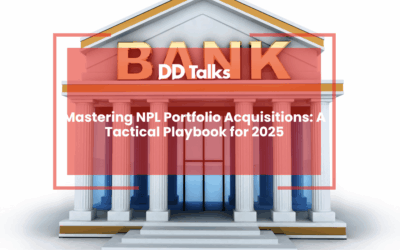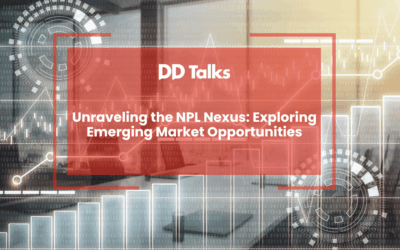Key Takeaways
- NPL portfolios represent both challenges for financial institutions and opportunities for specialized investors, with European volumes decreasing from €1 trillion to approximately €300 billion in recent years.
- Successful NPL valuation combines discounted cash flow analysis with market-based techniques, while incorporating sophisticated risk assessment frameworks that evaluate borrower characteristics, collateral quality, and legal enforcement pathways.
- Effective NPL due diligence requires thorough legal review, detailed collateral assessment, sophisticated borrower analysis, regulatory compliance verification, and rigorous data quality evaluation.
- Strategic acquisition approaches include competitive bidding, partnership structures, direct negotiation, and platform acquisitions, with timing considerations significantly impacting potential returns.
- Workout strategies balance active servicing versus outsourced recovery, with successful investors leveraging restructuring options, jurisdiction-specific legal expertise, asset management optimization, and technology enablement.
- NPL securitization provides opportunities to maximize returns through structured transactions that appeal to diverse investor classes while navigating complex regulatory requirements.
- Key risk factors include valuation uncertainties, servicing challenges, legal and regulatory hurdles, market liquidity concerns, and reputational considerations.
- Future trends shaping the NPL market include digital transformation, ESG considerations, cross-border transactions, economic cycle positioning, and emerging investor classes.
Table of Contents
- Understanding NPL Portfolios: Definition and Market Overview
- Valuation Methodologies for Distressed Debt Portfolios
- What Are the Critical Success Factors in NPL Due Diligence?
- Strategic Approaches to NPL Portfolio Acquisition
- Implementing Effective NPL Workout Strategies
- Maximizing Returns Through NPL Portfolio Securitization
- Navigating Risks in Distressed Debt Investing
- Future Trends Shaping NPL Portfolio Management
Understanding NPL Portfolios: Definition and Market Overview
Non-performing loan (NPL) portfolios consist of loans where borrowers have failed to make scheduled payments for a specified period, typically 90 days or more. These distressed assets represent a significant challenge for financial institutions but simultaneously create opportunities for specialised investors in the European banking landscape.
The European NPL market has evolved considerably since the 2008 financial crisis, with total NPL volumes decreasing from their peak of nearly €1 trillion to approximately €300 billion in recent years. However, regional disparities remain pronounced, with Southern European countries like Italy, Greece, and Portugal maintaining higher NPL ratios compared to Northern European counterparts.
NPL portfolios typically fall into several categories: corporate loans (often secured by commercial real estate or business assets), retail consumer loans (including credit cards and personal loans), residential mortgages, and specialised lending such as shipping or infrastructure finance. Each category presents unique challenges and opportunities for investors and servicers.
The NPL ecosystem encompasses multiple stakeholders, including originating banks seeking to divest problematic assets, specialised investors (hedge funds, private equity firms, and dedicated NPL funds), servicers who manage recovery processes, and advisors who facilitate transactions. Regulatory bodies like the European Central Bank and national authorities also play crucial roles in shaping market dynamics through guidelines and supervision frameworks that influence NPL management practices across the continent.
Valuation Methodologies for Distressed Debt Portfolios
Accurate valuation represents the cornerstone of successful NPL portfolio investment. The primary approach employed by sophisticated investors is discounted cash flow (DCF) analysis, which projects expected recovery amounts and timelines, then discounts these future cash flows to present value using appropriate risk-adjusted rates. This methodology requires granular loan-level data and sophisticated modelling capabilities to account for various recovery scenarios and timing uncertainties.
Market-based valuation techniques complement DCF approaches by benchmarking against comparable transactions. Investors analyse recent NPL portfolio sales with similar characteristics (asset class, geography, collateral type, etc.) to establish pricing parameters. However, the heterogeneous nature of NPL portfolios often limits direct comparability, necessitating adjustments for portfolio-specific factors.
Risk assessment frameworks have become increasingly sophisticated, incorporating probability of default (PD) and loss given default (LGD) models adapted specifically for non-performing assets. These frameworks evaluate borrower characteristics, collateral quality, legal enforcement pathways, and macroeconomic variables to estimate recovery probabilities and amounts.
Regulatory requirements significantly impact NPL valuation practices in Europe. The European Banking Authority’s guidelines on NPL management, along with the ECB’s expectations for significant institutions, have established more standardised approaches to NPL classification and provisioning. Additionally, NPL ratio analysis has become a critical component of regulatory oversight, influencing how banks value and manage their distressed portfolios. These regulatory frameworks have generally led to more conservative valuations by selling institutions, potentially creating value opportunities for specialised investors with superior workout capabilities.
What Are the Critical Success Factors in NPL Due Diligence?
Thorough legal and documentation review stands as the foundation of effective NPL due diligence. Successful investors meticulously examine loan agreements, security documents, and enforcement histories to identify potential legal obstacles or opportunities. This process involves verifying the enforceability of claims, assessing the completeness of documentation, and identifying any procedural defects that might impair recovery efforts. In jurisdictions with complex foreclosure processes, such as Italy or Greece, this legal review becomes particularly crucial.
Collateral assessment represents another vital component of NPL due diligence. For secured NPLs, the value and liquidity of underlying assets significantly impact recovery prospects. Best practices include independent property valuations, market liquidity analysis, and assessment of potential disposal challenges. Sophisticated investors develop jurisdiction-specific expertise in collateral enforcement timelines and costs, which vary dramatically across European markets.
Borrower analysis techniques have evolved beyond simple credit scoring to incorporate behavioural assessment and recovery propensity modelling. Effective due diligence examines borrower financial capacity, willingness to cooperate, and potential for restructuring. This analysis often includes segmentation of borrowers into strategic defaulters versus those experiencing genuine financial distress, enabling tailored recovery approaches.
Regulatory compliance considerations have gained prominence as European authorities increase scrutiny of NPL transactions. Due diligence must address data protection requirements, consumer protection regulations, and conduct risk considerations. Failure to identify compliance issues can result in significant post-acquisition liabilities or enforcement limitations.
Data quality evaluation underpins all aspects of NPL due diligence. Successful investors rigorously assess the completeness, accuracy, and consistency of portfolio data. This includes reconciliation of loan records, validation of reported collateral values, and verification of borrower information. Given that pricing decisions rely heavily on this data, leading investors often develop proprietary data enhancement methodologies to address information gaps and inconsistencies commonly found in NPL portfolios.
Strategic Approaches to NPL Portfolio Acquisition
Competitive bidding processes represent the predominant acquisition channel for NPL portfolios in Europe. Successful bidders distinguish themselves through superior data analysis capabilities, enabling more accurate valuation and confident pricing decisions. Sophisticated investors develop proprietary bidding strategies that balance competitive positioning against value discipline, often leveraging their unique operational advantages in specific asset classes or geographies to justify premium bids while maintaining return targets.
Partnership and consortium structures have emerged as powerful approaches for accessing larger NPL transactions. These collaborative arrangements allow investors to pool complementary capabilities—combining local servicing expertise with international capital, for instance—while distributing risk across multiple parties. Successful consortia carefully structure governance frameworks and align incentives to ensure efficient decision-making throughout the investment lifecycle.
Direct negotiation with originating institutions offers advantages for specialised investors with established relationships and demonstrated execution capabilities. These bilateral transactions often arise when sellers value certainty of execution, speed, or discretion over maximising price through competitive auctions. Building credibility as a reliable counterparty through consistent performance in previous transactions creates valuable opportunities for negotiated deals with preferential terms.
The strategic decision between platform acquisitions versus portfolio purchases represents a fundamental choice for NPL investors. Platform investments—acquiring the servicing operation alongside the loan portfolio—provide greater control over the workout process and capture additional value through the servicing business itself. However, they require operational expertise and management resources beyond pure investment capabilities. Portfolio-only purchases offer simplicity but necessitate effective oversight of third-party servicers.
Timing considerations within the NPL cycle significantly impact acquisition strategy. Counter-cyclical investors position themselves to acquire portfolios during periods of banking sector stress when supply exceeds demand, potentially securing more favourable pricing. Conversely, market entrants during competitive phases must identify specific inefficiencies or operational advantages to generate target returns despite higher acquisition prices.
Implementing Effective NPL Workout Strategies
The fundamental strategic decision in NPL portfolio management revolves around the choice between active servicing and outsourced recovery approaches. Leading investors increasingly favour direct control through proprietary servicing platforms or captive servicers, enabling tailored recovery strategies and alignment of incentives. This approach requires significant operational infrastructure but typically delivers superior returns through customised borrower engagement and more flexible decision-making. Outsourced models remain viable for investors lacking operational capabilities or entering new markets, though effective oversight and performance-based compensation structures become essential.
Restructuring and forbearance strategies have proven particularly effective for corporate and mortgage NPLs where borrowers retain some repayment capacity. Successful restructuring approaches balance borrower affordability with investor return requirements through measures such as term extensions, interest rate modifications, or partial debt forgiveness. The most sophisticated investors develop data-driven segmentation models to identify restructuring candidates and design sustainable modification terms that minimise re-default risk.
Legal enforcement pathways vary dramatically across European jurisdictions, with foreclosure timelines ranging from months to several years. Effective NPL managers develop jurisdiction-specific expertise in navigating these processes efficiently, often employing specialised legal partners with demonstrated success in particular courts or regions. Strategic decisions regarding when to pursue consensual resolutions versus enforcement actions significantly impact both recovery amounts and timelines.
Asset management optimisation represents a critical value creation lever, particularly for real estate collateral. Leading NPL investors develop capabilities to enhance property value through targeted improvements, repositioning, or entitlement changes prior to disposal. This approach requires real estate expertise beyond traditional loan servicing but can substantially increase recovery values, especially for commercial properties or development assets.
Technology enablement has transformed NPL collections and management practices. Advanced platforms now support automated borrower communication, predictive analytics for prioritisation, and real-time performance tracking. Digital channels facilitate borrower self-service options for information submission and payment arrangements. The most successful NPL managers leverage these technological capabilities to increase efficiency while improving borrower experience, ultimately enhancing recovery rates while reducing operational costs.
Maximizing Returns Through NPL Portfolio Securitization
Structuring NPL securitisation transactions requires specialised expertise to transform heterogeneous distressed assets into standardised securities attractive to capital markets investors. Successful structures typically feature multiple tranches with varying risk-return profiles, enabling access to diverse investor classes. The senior tranches, often rated by credit agencies, appeal to institutional investors seeking lower-risk exposure to the NPL market. Mezzanine and junior tranches, carrying higher yields but greater risk, attract specialised credit funds and alternative investors. The originating NPL investor frequently retains the most subordinated tranche to align interests and satisfy regulatory requirements.
Investor appetite for NPL securitisations has evolved significantly, with growing participation from institutional investors seeking yield in the prolonged low-interest-rate environment. Insurance companies, pension funds, and asset managers increasingly allocate capital to senior NPL securitisation tranches, attracted by their relative value compared to traditional fixed-income investments. Specialised credit funds target mezzanine positions, while private equity and hedge funds focus on junior tranches offering potential for equity-like returns.
Regulatory considerations substantially influence NPL securitisation structures in Europe. The EU Securitisation Regulation, implemented in 2019, established a comprehensive framework governing these transactions, including transparency requirements, due diligence obligations, and risk retention rules. Additionally, the significant risk transfer (SRT) framework determines whether originating banks can achieve capital relief through securitisation, directly impacting transaction economics.
Risk retention requirements mandate that originators, sponsors, or original lenders maintain a material economic interest of at least 5% in securitisation transactions. This “skin in the game” approach aims to align incentives between transaction originators and investors. For NPL securitisations, these requirements often influence structural decisions, including retention methods (vertical slice, first-loss tranche, or randomly selected exposures) and impact overall returns.
Performance tracking and reporting systems provide critical transparency for NPL securitisation investors. Leading transactions feature comprehensive reporting packages detailing collection performance, collateral status, and servicing activities. Advanced analytics platforms enable investors to monitor key performance indicators against business plan projections and identify potential issues requiring intervention. This transparency has proven essential for building investor confidence in this specialised market segment.
Future Trends Shaping NPL Portfolio Management
Digital transformation is revolutionising NPL management across Europe, with artificial intelligence and machine learning capabilities enabling more sophisticated borrower segmentation, predictive analytics for recovery optimisation, and automated decision-making for routine cases. Advanced data visualisation tools provide portfolio managers with real-time insights into performance trends and emerging risks. Digital communication channels are enhancing borrower engagement through personalised, multi-channel approaches that improve response rates while reducing operational costs. Leading NPL investors are making significant technology investments to establish competitive advantages in this increasingly sophisticated market.
Environmental, Social, and Governance (ESG) considerations are rapidly gaining prominence in distressed debt investing. Institutional investors increasingly require NPL managers to demonstrate responsible approaches to borrower engagement, sustainable practices in collateral management (particularly for real estate assets), and transparent governance frameworks. Forward-thinking NPL investors are developing specific ESG policies addressing borrower vulnerability, sustainable property management, and ethical collection practices. This trend is likely to accelerate as regulatory attention to these issues intensifies across European markets.
Cross-border NPL transactions continue to grow in importance as investors seek diversification and regulatory arbitrage opportunities. These complex deals require specialised expertise in multiple legal systems, servicing capabilities across jurisdictions, and understanding of diverse borrower behaviours. Successful cross-border investors develop standardised due diligence methodologies adaptable to different markets while maintaining local expertise in each jurisdiction. The harmonisation efforts under the European Banking Union are gradually reducing some cross-border friction points, though significant national differences persist.
Economic cycles profoundly influence NPL portfolio strategies, with countercyclical positioning often generating superior returns. The anticipated economic challenges following the pandemic and current geopolitical tensions are likely to generate new NPL formation across Europe, potentially creating opportunities for well-capitalised investors. Sophisticated market participants are preparing for this next wave by securing funding commitments, enhancing operational capabilities, and developing relationships with potential sellers.
Emerging investor classes are reshaping the competitive landscape for NPL portfolios. Sovereign wealth funds, pension systems, and institutional asset managers are increasingly allocating capital to this asset class, either through direct investment teams or specialised fund structures. These investors typically bring longer investment horizons and lower
Frequently Asked Questions
What is an NPL portfolio?
An NPL (Non-Performing Loan) portfolio consists of loans where borrowers have failed to make scheduled payments for a specified period, typically 90 days or more. These distressed assets are categorized into corporate loans (secured by commercial real estate or business assets), retail consumer loans (credit cards and personal loans), residential mortgages, and specialized lending such as shipping or infrastructure finance.
How are NPL portfolios valued?
NPL portfolios are primarily valued using discounted cash flow (DCF) analysis, which projects expected recovery amounts and timelines, then discounts these future cash flows to present value using risk-adjusted rates. This is complemented by market-based valuation techniques that benchmark against comparable transactions, and sophisticated risk assessment frameworks incorporating probability of default (PD) and loss given default (LGD) models specifically adapted for non-performing assets.
What are the key factors in successful NPL due diligence?
Critical success factors in NPL due diligence include: thorough legal and documentation review to verify enforceability of claims; comprehensive collateral assessment to determine value and liquidity of underlying assets; advanced borrower analysis to evaluate financial capacity and willingness to cooperate; regulatory compliance verification to address data protection and consumer protection requirements; and rigorous data quality evaluation to ensure completeness and accuracy of portfolio information.
What strategies maximize returns from NPL investments?
Returns from NPL investments are maximized through: strategic decisions between active servicing and outsourced recovery approaches; effective restructuring and forbearance strategies for viable borrowers; efficient navigation of legal enforcement pathways; optimization of asset management for collateral properties; implementation of technology-enabled collection processes; and potential securitization of portfolios to access capital markets and create liquidity.
What risks do NPL investors face?
NPL investors face several key risks: pricing and valuation risks due to uncertainty in recovery amounts and timelines; servicing and operational challenges that can reduce realized returns; legal and regulatory hurdles across different jurisdictions; market liquidity concerns affecting both acquisition and exit strategies; and reputational considerations regarding borrower treatment and social impact that may attract regulatory scrutiny.
How is technology changing NPL portfolio management?
Technology is transforming NPL management through artificial intelligence and machine learning capabilities that enable sophisticated borrower segmentation and predictive analytics for recovery optimization. Advanced data visualization tools provide real-time performance insights, while digital communication channels enhance borrower engagement through personalized, multi-channel approaches that improve response rates while reducing operational costs.
What future trends are shaping the NPL market?
Key trends shaping the future of NPL portfolio management include: digital transformation through AI and automation; growing importance of ESG considerations in distressed debt investing; increasing cross-border NPL transactions as investors seek diversification; cyclical opportunities created by economic challenges following the pandemic and geopolitical tensions; and the emergence of new investor classes including sovereign wealth funds, pension systems, and institutional asset managers entering the market.




0 Comments